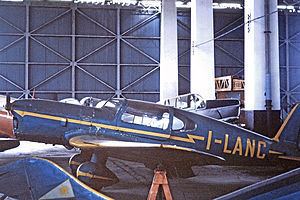Top speed 250 km/h Length 6.77 m Manufacturer SAI Ambrosini | Wingspan 11 m First flight 1937 Designer Sergio Stefanutti | |
 | ||
The Ambrosini SAI.2S was a four-seat light aircraft produced in Italy shortly before World War II.
Contents
Design and construction
It was a low-wing, cantilever cabin monoplane of conventional configuration with fixed, tailwheel undercarriage. It first appeared in 1937 and was initially powered by the Alfa Romeo 115-I engine of 185 horsepower (138 kW). At least one example was converted postwar with the de Havilland Gipsy Six Series II of 205 horsepower (153 kW).
The aircraft was primarily of wooden construction, the fuselage being a wooden monocoque and the two-spar wing having a duralumin-covered centre-section built integral with the fuselage and internally reinforced with steel tubes. The wing carried Handley Page slots and split flaps, and dual controls were fitted.
Operation
The type was produced in small numbers, for use by private pilot owners. Two examples were operational in 1965. One aircraft was still extant As of 2006, and is preserved at the Gianni Caproni Museum of Aeronautics at Trento Airport.
Despite the similar designation, this design was unrelated to the earlier SAI.2
Specifications
General characteristics
Performance
